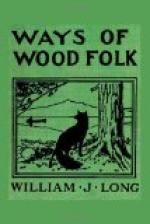One spring a farmer, with whom I sometimes go shooting, determined to try with young birds. He found a black duck’s nest in a dense swamp near a salt creek, and hatched the eggs with some others under a tame duck. Every time he approached the pen the little things skulked away and hid; nor could they be induced to show themselves, although their tame companions were feeding and running about, quite contented. After two weeks, when he thought them somewhat accustomed to their surroundings, he let the whole brood go down to the shore just below his house. The moment they were free the wild birds scurried away into the water-grass out of sight, and no amount of anxious quacking on the part of the mother duck could bring them back into captivity. He never saw them again.
This habit which the young birds have of skulking away out of sight is a measure of protection that they constantly practise. A brood may be seen on almost any secluded pond or lake in New England, where the birds come in the early spring to build their nests. Watching from some hidden spot on the shore, one sees them diving and swimming about, hunting for food everywhere in the greatest freedom. The next moment they scatter and disappear so suddenly that one almost rubs his eyes to make sure that the birds are really gone. If he is near enough, which is not likely unless he is very careful, he has heard a low cluck from the old bird, which now sits with neck standing straight up out of the water, so still as to be easily mistaken for one of the old stumps or bogs among which they are feeding. She is looking about to see if the ducklings are all well hidden. After a moment there is another cluck, very much like the other, and downy little fellows come bobbing out of the grass, or from close beside the stumps where you looked a moment before and saw nothing. This is repeated at frequent intervals, the object being, apparently, to accustom the young birds to hide instantly when danger approaches.
So watchful is the old bird, however, that trouble rarely threatens without her knowledge. When the young are well hidden at the first sign of the enemy, she takes wing and leaves them, returning when danger is over to find them still crouching motionless in their hiding places. When surprised she acts like other game birds,—flutters along with a great splashing, trailing one wing as if wounded, till she has led you away from the young, or occupied your attention long enough for them to be safely hidden; then she takes wing and leaves you.




